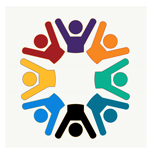
Starting Points
- Establish a team for identifying strengths and needs for the school in practices and policies that encourage collaboration with community members to connect students, families, and staff to expanded learning opportunities, community services, and civic participation.
- Use the School Level Starting Points Family, School, and Community Partnerships Inventory to begin discussion related to how the school embraces healthy two-way communication between the school and all families, and plan for action steps.
- Use the Action Plan Template as part of your purposeful and informed planning for action steps that lead to a vision of family, school and community partnerships in your school community.
 Collaborating with the Community
Collaborating with the Community
The focus is on families and school staff collaborating with community members to connect students, families, and staff to expanded learning opportunities, community services, and civic participation. Engaging community members, businesses, and organizations as partners in children’s education can improve learning communities through benefits such as expanded learning opportunities, broad-based support for increased school funding, and quality after school programs.
Partnerships that connect a school with businesses, hospitals, colleges, service clubs, social service agencies, youth organizations, public housing projects, labor unions, churches, and other community groups can turn a neighborhood into a thriving place to live, work, and raise a family. Many school districts are creating full-service community schools that offer one-stop resource centers for families and residents. Schools are opening their doors and allowing their communities to use facilities and meeting rooms as a way of applying school resources to solve problems.

There is one main goal for Collaborating with the Community:
Connect the school with community resources:
Parent and school leaders should work closely with neighborhood associations, government agencies, businesses, and universities to strengthen the school. These collaborations should make resources available to students, school staff, and families and build a family-friendly community.
- What links to community resources has the school forged?
- Have parents and families been part of that process?
- In what ways has support from community partners been organized?
Access the resources below for methods to encourage collaboration.
Action Steps
What Parents and School Staff Can Do to Collaborate with the Community
GETTING STARTED
- Establish a team for identifying strengths and needs for the school in practices and policies that foster collaborating with the community.
- Use School Level Starting Points Family, School, and Community Partnerships Inventory to begin discussion related to characteristics of family-friendly schools, assess your school, and plan for action steps.
- Establish a core of partners in and around the school based on the results you want to achieve.
- Build trust among the partners and an understanding of the contributions each organization can bring, as well as their limitations.
- Develop a shared vision among the partners for what type of success the partnership will produce.
- Make sure partnership activities strengthen families and link to student learning.
WHAT PARENTS AND PARENT LEADERS CAN DO
- Reflect on the results of the Reflection/Assessment Rubric for Parent Leaders and School Staff: Collaborating with the Community with a team of stakeholders including parents, teachers, and administrators to identify strengths and needs for the school in practices and policies that support collaboration with community.
- Host a community resource fair that highlights programs that support the cultural, recreational, academic, health, social, and other needs of families.
- Reach out to senior/retired citizens and invite them to volunteer at the school.
- Work with the local newspaper to promote special events that are happening at the school.
- Invite school alumni to participate in an alumni sponsors program through which they volunteer time or make a donation to the school.
- Develop paycheck-size cards with tips for how parents can foster their children’s success. Contact employers about including the cards with employee paychecks.
WHAT SCHOOL LEADERS AND STAFF CAN DO
- Reflect on the results of the Reflection/Assessment Rubric for Parent Leaders and School Staff: Collaborating with the Community with a team of stakeholders including parents, teachers, and administrators to identify strengths and needs for the school in practices and policies in collaborating with the community.
- Sponsor an annual Give Back Day on which students go into the community to perform needed work or services.
- Include in the local chamber of commerce newsletter a request from the school district superintendent for local employers to encourage their employees to attend parent-teacher conferences and other involvement activities.
- Invite local businesses to sponsor community resource workshops for teachers during the summer to help them learn about the educational, cultural, and business resources in the community.
- Host a community breakfast at the school for local businesses and civic leaders.
Resources and Tools

Quick Tips: Focus on Collaboration with the Community
Refer to these quick tips for practices, ideas, and references that promote family engagement practices with a clear focus on a shared responsibility for student success.

Reflection/Assessment Rubric for Parent Leaders and School Staff: Collaborating with the Community
Use this rubric to help evaluate how well your school partners with families and community to promote shared leadership and encourage collaboration between all parties involved in a child’s education. Think about where you see your school and/or district in the process and strategies used to encourage collaboration with the community by marking the box that most clearly matches what you are doing now. Reflect on the results as you plan and focus efforts on a shared responsibility for student success.
PDF coming soon
